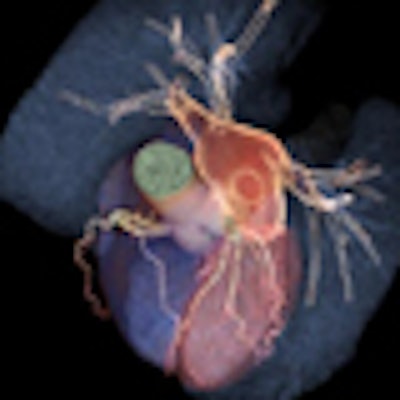
The high accuracy and negative predictive value of CT coronary angiography (CTA) held steady in a trial involving 16 centers and a cohort of patients presenting with chest pain and a buffet table of cardiovascular risk factors.
For the study, Dr. James Min and his colleagues from Weill Cornell Medical College in New York City recruited 243 patients in 16 institutions with stable or unstable angina who were scheduled for invasive coronary angiography.
"We know that prior studies examining the diagnostic performance of coronary CTA have been primarily limited to a single center," Min said. "Similarly, prior studies examining the efficacy of coronary CT angiography have been primarily examined in populations with a high prevalence of coronary artery disease."
Other participants in the ACCURACY (Assessment by Coronary Computed Tomographic Angiography of Individuals Undergoing Invasive Coronary Angiography) trial included Dr. David Dowe and colleagues from Atlantic Medical Imaging of Atlantic City, NJ; Dr. James Jollis and colleagues from Duke University Medical Center in Durham, NC; and Dr. Matthew Budoff and his team from the Biomedical Research Institute at Harbor-UCLA Medical Center in Los Angeles.
"Our aim was to perform a prospective multicenter study using 64-row CTA to evaluate its diagnostic performance for the detection and exclusion of coronary artery stenosis in patients presenting with chest pain," Min said in a presentation at the 2007 RSNA meeting in Chicago.
Candidates were excluded for typical contraindications to CTA, such as allergy to iodine or beta-blockers, renal insufficiency, heart rate faster than 100 bpm, and hemodynamic instability.
"Subjects were not excluded for baseline coronary calcium score, nor were they excluded for baseline BMI (body mass index)," Min noted.
In fact, the cohort was a challenge. Forty percent of the patients were obese, 73% had family history of cardiovascular disease, nearly 70% had hyperlipidemia or hypertension, about 20% had diabetes mellitus, and 55% were actively smoking.
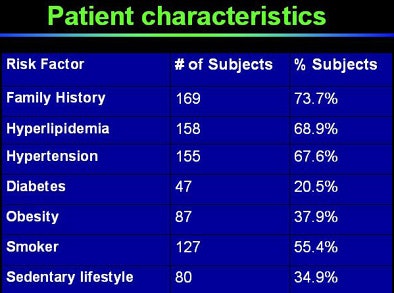 |
| Many of the chest pain patients in the study presented with multiple risk factors for coronary artery disease. All images courtesy of Dr. James Min. |
The 243 subjects had a mean age of 57 years (±10, range 31-82), and 138 (59.5%) were men. The mean coronary artery calcium score was 301, the mean BMI was 31.4. "This was an obese population," Min said.
Eleven subjects were excluded from the cohort of 243, and conventional angiography for two patients had not yet been reported at the time of the presentation, leaving a total of 229 patients for analysis.
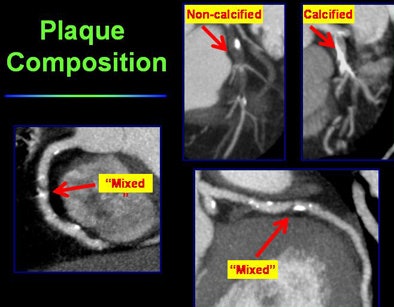 |
| The readers distinguished among calcified, noncalcified, and "mixed" plaque types in CTA images. |
Coronary CTA was performed using a 64-detector-row scanner (LightSpeed VCT, GE Healthcare, Chalfont St. Giles, U.K.) and retrospective ECG gating. A timing bolus was used to determine scan start times. Because retrospective gating was used, typical radiation doses were in the 12 mSv range, Min told AuntMinnie.com.
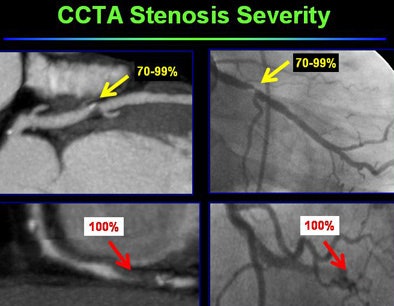 |
| Readers sought to distinguish between severe stenosis (70% to 90% luminal narrowing) and complete vessel blockage (100%) in coronary CTA images (left) and angiography images (right). |
"ECG modulation was used for every scan to reduce radiation, and images were reconstructed for three phases -- between 70% to 80% of the cardiac cycle in 5% increments, and from 5% to 95% of the cardiac cycle by 10% increments," Min explained.
Patients were scanned in a triple-phase protocol using dual contrast injectors. The first phase used iodixanol (60 cc at 5 cc/sec), followed by a 50/50 mixture of iodixanol and saline (20 cc at 3.5 cc/sec) and a saline flush (50 cc at 3.5 cc/sec).
All reconstruction formats were permitted for image analysis, including axial or oblique maximum intensity projections (MIPS), curved multiplanar reconstructions (MPRs), etc. Efficacy of coronary CTA was based on consensus (at least two of three readers) for each patient, vessel, and segment.
Quantitative coronary angiography, which served as the reference standard, was performed within 48 hours and three weeks of CTA. The 15-segment American Heart Association model was used for evaluating both angiography and CTA exams.
Conventional coronary angiography found a total of 82 stenoses 50% or greater in 49 (21.3% prevalence) patients, and 31 70% or greater stenoses in 28 (12.1% prevalence) patients.
Compared to angiography, coronary CTA's sensitivity, specificity, positive predictive value (PPV), and negative predictive value (NPV) for detecting greater than 70% stenoses were 91%, 84%, 51%, and 98%, respectively, and 85%, 92%, 68%, 99%, respectively, for stenoses greater than 50%. Accuracy was high for both per-patient and per-vessel analyses, Min said.
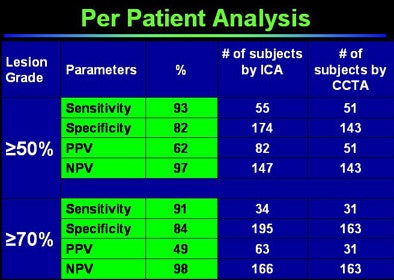 |
| In both per-patient (top) and per-vessel results (bottom) coronary CTA yielded high accuracy and negative predicative values. |
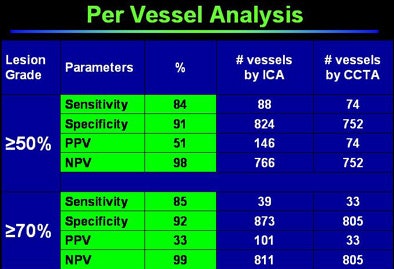 |
The results show the high accuracy of current-generation 64-slice coronary CTA to detect stenosis of greater than 50% and greater than 70%, Min said, adding that these are the first prospective multicenter results to compare 64-row coronary CTA to angiography without exclusion based on calcium score or BMI.
"In patients with chest pain who are electively referred for coronary invasive angiography, the high negative predictive values of 97% to 99% indicate that CTA is a highly effective noninvasive alternative to exclude coronary artery stenosis," he said. "I think the accuracy of the results in a prospective multicenter (setting) definitely establish a high diagnostic accuracy and high negative predictive value of 64-detetctor-row CT angiography in chest pain patients with an intermediate prevalence of coronary artery disease."
Additional studies will be performed with the study data. The results will be compared to nuclear SPECT, for example, and the cost-effectiveness of CTA versus the standard of care (pharmacologic stress testing and conventional angiography) evaluated. Finally, the team will look at "plaque composition patterns as they relate to significant obstructive coronary artery stenosis, and obviously inter-reader, interaction, and interslice variabilities," Min said.
By Eric Barnes
AuntMinnie.com staff writer
January 18, 2007
Related Reading
Coronary CTA study aims for lowest dose, January 11, 2008
Pending Medicare decision roils cardiac CTA, January 8, 2008
Sublingual nitroglycerin improves coronary CTA, December 31, 2007
Low-dose coronary CTA diagnoses most patients, November 28, 2007
Copyright © 2008 AuntMinnie.com




















